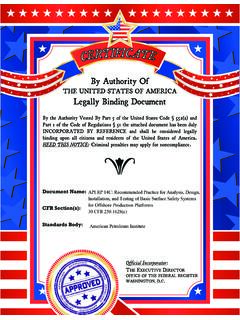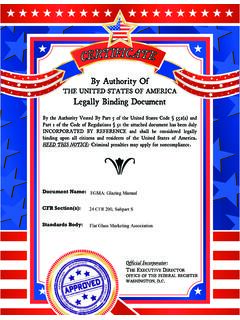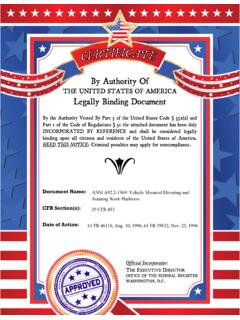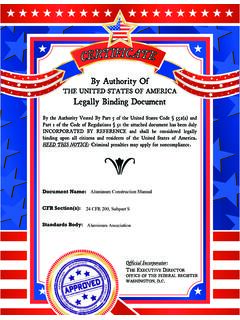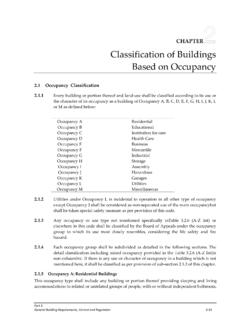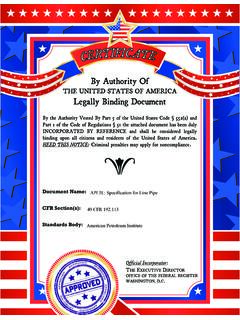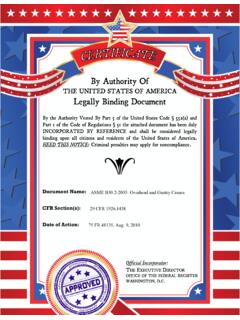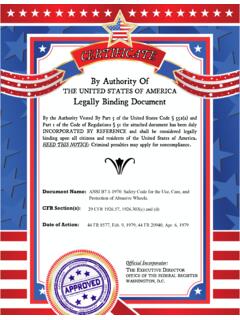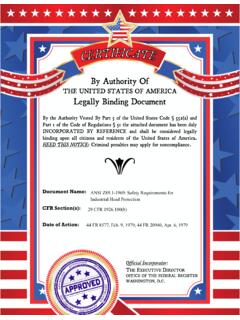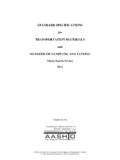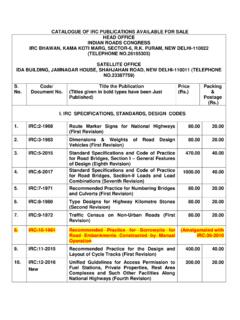Transcription of IS 4326 (1993): Code of practice for earthquake resistant ...
1 Disclosure to Promote the Right To Information Whereas the Parliament of India has set out to provide a practical regime of right to information for citizens to secure access to information under the control of public authorities, in order to promote transparency and accountability in the working of every public authority, and whereas the attached publication of the Bureau of Indian Standards is of particular interest to the public, particularly disadvantaged communities and those engaged in the pursuit of education and knowledge, the attached public safety standard is made available to promote the timely dissemination of this information in an accurate manner to the public. 1 + , 1 + 0 1 ' 5 . Mazdoor Kisan Shakti Sangathan Jawaharlal Nehru The Right to Information, The Right to Live Step Out From the Old to the New . IS 4326 (1993): Code of practice for earthquake resistant design and construction of buildings [CED 39: earthquake Engineering]. ! $ ' + - . Satyanarayan Gangaram Pitroda Invent a New India Using Knowledge.
2 ! > 0 B .. Bhart hari N ti atakam Knowledge is such a treasure which cannot be stolen . IS 4326 : 1993. (Reaffirmed 2003). Edition (2005-01). Indian Standard earthquake resistant design AND. CONSTRUCTION OF BUILDINGS . CODE OF practice . ( Second Revision ). (Incorporating Amendment Nos. 1, 2 & 3). UDC (026). BIS 2005. BUREAU OF INDIAN STANDARDS. MANAK BHAVAN , 9 BAHADUR SHAH ZAFAR MARG. NEW DELHI 110002. Price Group 11. earthquake Engineering Sectional Committee, CED 39. FOREWORD. This Indian Standard was adopted by the Bureau of Indian Standards, after the draft finalized by the earthquake Engineering Sectional Committee had been approved by the Civil Engineering Division Council. Himalayan-Naga Lushai region, Indo-Gangetic Plain, Western India and Kutch and Kathiawar regions are geologically unstable parts of the country and some devastating earthquakes of the world have occurred there. A major part of the peninsular India, has also been visited by moderate earthquakes, but these were relatively few in number and had considerably lesser intensity.
3 It has been a long felt need to rationalize the earthquake resistant design and construction of structures taking into account seismic data from studies of these Indian earthquakes, particularly in view of the heavy construction programme at present all over the country. It is to serve this purpose that IS 1893 : 1984 Criteria for earthquake resistant design of structures' was prepared. It covered the seismic design considerations for various structures. As an adjunct to IS 1893, IS 4326 Code of practice for earthquake resistant design and construction of buildings' was prepared in 1967 and subsequently revised in 1976 to be in line with IS 1893 : 1975. Since 1984 revision of IS 1893 was minor, it did not require a revision of IS 4326. An expansion of IS 4326 was infact thought of immediately after the Bihar earthquake of August 1988 when greater attention was needed on low-strength brickwork and stone masonry as well as earthen buildings; also repair, restoration and strengthening of earthquake -damaged buildings posed a serious issue.
4 After intense deliberations, the subcommittee CED 39 : 1 decided to issue separate standards to cover these topics. It was further decided to cover detailing of reinforced concrete for achieving ductility in a separate standard to be used with IS 456 : 1978 Code of practice for plain and reinforced concrete ( third revision )'. The present revision is based on these considerations. Recommendations regarding restrictions on openings, provision of steel in various horizontal bands and vertical steel at corners and junctions in walls and at jambs of openings are based on a range of calculations made using design seismic coefficient and the ductility of steel reinforcement. Many of the provisions have also been verified experimentally on models by shake table tests. The following are the major changes besides minor amendments affected in this revision of the standard: a) Low strength brickwork and stone masonry are removed and developed into a separate standard;. b) Clauses on ductility details have been removed and developed into a separate standard.
5 C) Building categories have been introduced based on basic seismic coefficient, soil-foundation factor and importance factor as per IS 1893 : 1984; and d) Size and position of openings in bearing walls has been specified in greater detail. In this standard, it is intended to cover the specified features of design and construction for earthquake resistance of buildings of conventional types. In case of other buildings, detailed analysis of earthquake forces will be necessary. Recommendations regarding restrictions on openings, provision of steel in various horizontal bands and vertical steel at corners and junctions in walls and at jambs of openings are based on a range of calculations made using steel design seismic coefficient and the ductility of steel reinforcement. Many of the provisions have also been verified experimentally on models by shake table tests. The Sectional Committee responsible for the preparation of this standard has taken into consideration the views of all who are interested in this field and has related the standard to the prevailing practices in the country.
6 Due weightage has also been given to the need for international co-ordination among the standards and practices prevailing in different countries of the world. This edition incorporates Amendment No. 1 (December 1995), Amendment No. 2 (April 2002). and Amendment No. 3 (January 2005). Side bar indicates modification of the text as the result of incorporation of the amendments. For the purpose of deciding whether a particular requirement of this standard is complied with, the final value, observed or calculated, expressing the result of a test or analysis, shall be rounded off in accordance with IS 2 : 1960 Rules for rounding off numerical values ( revised )'. The number of significant places retained in the rounded off value should be the same as that of the specified value in this standard. IS 4326 : 1993. Indian Standard earthquake resistant design AND. CONSTRUCTION OF BUILDINGS . CODE OF practice . ( Second Revision ). 1 SCOPE IS No. Title This standard deals with the selection of 1904 : 1986 Code of practice for design and materials, special features of design and construction of foundations in construction for earthquake resistant buildings soils : General requirements including masonry construction using ( third revision ).
7 Rectangular masonry units, timber construction 1905 : 1987 Code of practice for structural use and buildings with prefabricated flooring/ of unreinforced masonry ( third roofing elements. revision ). Guidelines for earthquake resistant 2212 : 1991 Code of practice for brickwork buildings constructed using masonry of low ( first revision ). strength and earthen buildings are covered in 2751 : 1979 Recommended practice of welding separate Indian Standards. mild steel plain and deformed bars for reinforced construction 2 REFERENCES ( first revision ). The Indian Standards listed below are the 3414 : 1968 Code of practice for design and necessary adjuncts to this standard: installation of joints in buildings IS No. Title 9417 : 1989 Recommendations for welding cold worked bars for reinforced 456 : 1978 Code of practice for plain and steel construction ( first revision ). reinforced concrete ( third 13920 : 1993 Code of practice for ductility revision ) detailing of reinforced concrete 883 : 1992 Code of practice for design of structures subjected to seismic structural timber in buildings forces ( fourth revision ).
8 1597 Code of practice for construction 3 TERMINOLOGY. (Part 2) : of stone masonry : Part 2 Ashlar 1992 masonry ( first revision ) For the purpose of this standard, the 1641 : 1988 Code of practice for fire safety of following definitions shall apply. buildings (general) : General Separation Section principles of fire grading and classification ( first revision ) A gap of specified width between adjacent 1642 : 1989 Code of practice for fire safety of buildings or parts of the same building, either buildings (general) : Details of left uncovered or covered suitably to permit construction ( first revision ) movement in order to avoid hammering due to 1643 : 1988 Code of practice for fire safety of earthquake . buildings (general) : Exposure hazard ( first revision ) Crumple Section 1644 : 1988 Code of practice for fire safety of A separation section filled with appropriate buildings (general) : Exit material which can crumple or fracture in an requirements and personal earthquake .
9 Hazard ( first revision ). 1646 : 1982 Code of practice for fire safety of Centre of Rigidity buildings (general) : Electrical installations ( first revision ) The point in a structure where a lateral force 1893 : 1984 Criteria for earthquake resistant shall be applied to produce equal deflections of design of structures ( fourth its components at any one level in any revision ) particular direction. 1. IS 4326 : 1993. Shear Wall Lightness A wall designed to resist lateral force in its own Since the earthquake force is a function of plane. Braced frames, subjected primarily to mass, the building shall be as light as possible axial stresses, shall be considered as shear consistent with structural safety and functional walls for the purpose of this definition. requirements. Roofs and upper storeys of buildings, in particular, should be designed as Space Frame light as possible. A three-dimensional structural system Continuity of Construction composed of interconnected members, without shear or bearing walls, so as to function as a As far as possible, the parts of the complete self-contained unit with or without building should be tied together in such a the aid of horizontal diaphragms or floor manner that the building acts as one unit.
10 Bracing systems. For parts of buildings between separation or crumple sections or expansion joints, floor Vertical Load Carrying Frame slabs shall be continuous throughout as far as A space frame designed to carry all the vertical possible. Concrete slabs shall be rigidly loads, the horizontal loads being resisted by connected or integrally cast with the support shear walls. beams. Moment resistant Frame Additions and alterations to the structures shall be accompanied by the A space frame capable of carrying all vertical provision of separation or crumple sections and horizontal loads, by developing bending moments in the members and at joints. between the new and the existing structures as far as possible, unless positive measures are Moment resistant Frame with Shear taken to establish continuity between the Walls existing and the new construction. A space frame with moment resistant joints Projecting and Suspended Parts and strengthened by shear walls to assist in Projecting parts shall be avoided as far as carrying horizontal loads.
